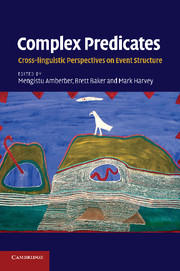Book contents
- Frontmatter
- Contents
- List of figures and tables
- List of contributors
- Preface
- 1 Introduction: complex predicates
- 2 Complex predicate formation
- 3 The light verb jungle: still hacking away
- 4 Events and serial verb constructions
- 5 Cotemporal serial verb constructions in White Hmong
- 6 Activity incorporates in some Athabaskan languages
- 7 Warlpiri verbs of change and causation: the thematic core
- 8 Complex predicates in Wambaya: detaching predicate composition from syntactic structure
- 9 Compound verbs and ideophones in Wolaitta revisited
- 10 The structure of the light verb construction in Amharic
- Index
2 - Complex predicate formation
Published online by Cambridge University Press: 07 May 2010
- Frontmatter
- Contents
- List of figures and tables
- List of contributors
- Preface
- 1 Introduction: complex predicates
- 2 Complex predicate formation
- 3 The light verb jungle: still hacking away
- 4 Events and serial verb constructions
- 5 Cotemporal serial verb constructions in White Hmong
- 6 Activity incorporates in some Athabaskan languages
- 7 Warlpiri verbs of change and causation: the thematic core
- 8 Complex predicates in Wambaya: detaching predicate composition from syntactic structure
- 9 Compound verbs and ideophones in Wolaitta revisited
- 10 The structure of the light verb construction in Amharic
- Index
Summary
Introduction
The term ‘complex predicate’ has a wide usage, including, for example, serial verb constructions, light verb constructions, and particle + verb constructions, among others. An examination of the data provided by analysts in their discussions of complex predicates shows that monoclausality is the critical factor in determining whether a construction involves a complex predicate or not. Complex predicates are monoclausal structures involving two or more predicating morphemes. Butt (this volume) is explicit on this point.
[T]he term complex predicate is used to designate a construction that involves two or more predicational elements (such as nouns, verbs, and adjectives) which predicate as a single element, i.e. their arguments map onto a monoclausal syntactic structure.
We show that monoclausality as a criterion does not determine a unitary set of predicate structures. Rather, we show that there are two quite distinct ways of combining predicate information within monoclausal structures. We call one method ‘merger’ because the predicate information from the contributing constituents merges where they have common conceptual structure. This method produces predicate structures whose range classes with the range of predicate structures found in monomorphemic predicates. We propose that there are constraints on the conceptual structure of monomorphemic predicates which also apply to merger constructions. We discuss the constraints on monomorphemic predicates in Section 2.4.
We call the other method ‘coindexation’ because relations among the contributing predicates are constrained only by a requirement that some of their arguments must be coindexed. This method produces multi-predicate structures whose range classes with multi-clausal structures.
- Type
- Chapter
- Information
- Complex PredicatesCross-linguistic Perspectives on Event Structure, pp. 13 - 47Publisher: Cambridge University PressPrint publication year: 2010
- 18
- Cited by



